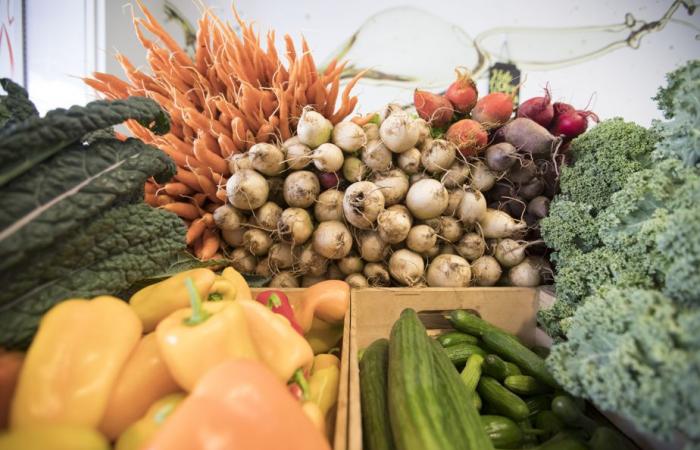“Every time I go shopping, I ask myself this question. Should I favor organic foods (even if they are not produced in Quebec) or local foods (even if it means choosing non-organic)? », asks Chantal.
Published at 12:48 a.m.
Updated at 5:00 a.m.
Both options have advantages for the environment, but also some disadvantages.
The local, beyond transport
When it comes to local food, when we opt, for example, for a Quebec tomato rather than a Mexican one, we often think of the many kilometers it did not have to travel to get here.
But when you do the math, you realize that the plane doesn’t weigh much in the balance. Generally speaking, transportation represents only 10 to 15% of the carbon footprint of food.
“What really matters is how they are produced,” underlines Catherine Houssard, analyst at the International Reference Center for Life Cycle Analysis and Sustainable Transition (CIRAIG).
For our example of a tomato, the carbon footprint leans more in favor of that of Mexico, compared to a tomato that would have grown in a heated greenhouse in Quebec.
But be careful, the “Products of Quebec” labels should not be neglected.
Local has the advantage of encouraging local producers, who often have operations on a smaller scale or less intensive than those of imported foods.
Derek Lynch, professor in the department of plant, food and environmental sciences at Dalhousie University in Halifax
“And encouraging local producers also allows them to have enough room to adopt good environmental practices,” adds Caroline Halde, professor in the Faculty of Agricultural and Food Sciences at Laval University.
Organic, low yield?
When we dissect the environmental footprint of a tomato, whatever its origin, “what has a major impact is the use of synthetic pesticides and fertilizers,” says Caroline Halde.
Since it prohibits the use of these products, organic food has undeniable positive effects on water pollution and soil biodiversity, pollinators, birds, etc. Not to mention the health benefits for consumers and farmers.
So just like buying local, buying organic helps encourage farmers to adopt less intensive and more environmentally friendly practices.
The main criticism we could make of organic? A traditional field offers a better yield, for the same land use. This reality increases the carbon footprint of organic tomatoes, compared to that of tomatoes produced in the same place, but in a “traditional” way.
This performance-based vision, however, is being questioned in the scientific community. The initial hypothesis considers that a field, organic or traditional, would produce infinitely. However, traditional agriculture leads to impoverishment of soils, which become exhausted and become unusable in the long term.
Critics of organic also say that if we converted all current fields into organic fields, it would be necessary to clear large plots of land to feed the entire planet. But once again, for Catherine Houssard, this discourse is biased, because it immediately excludes other ways of adapting one’s diet, such as eating less meat, which allow us to occupy less land.
Verdict ?
The three experts agree: there is no need to particularly favor one option over another. “It’s a bit of a false debate; the best is to buy both,” says Caroline Halde.
And without necessarily choosing organic or local, we must above all encourage sustainable agricultural practices, emphasizes Derek Lynch.
“What matters above all is the philosophy of the farmer, the way he manages his farm. If it is focused mainly on productivity, or conversely, if it takes a less intensive approach, which takes advantage of the ecological services provided by the soil,” he explains.
For the three experts, if the environmental footprint of our food concerns us, this dilemma between organic and local is perhaps not the right question to ask.
Reducing your meat consumption and limiting food waste remain the number one actions to take to reduce the impact of your diet.
Caroline Halde, professor in the Faculty of Agricultural and Food Sciences at Laval University
In addition, it also helps ease the pressure on your wallet: 1 kg of lentils costs much less than 1 kg of beef.
“The consumer has a lot of power, without really realizing it, when they are shopping for groceries. What we buy, what we ask for, pushes producers to adapt and governments to take measures in the right direction,” underlines Catherine Houssard.
17 %
The approximate percentage of food in the carbon footprint of a Quebecer, i.e. 1.5 tonnes of CO equivalent2
Source: Institute of Statistics of Quebec, 2017
They said
It is clear that our elected officials lack vision and courage when it comes to forest management, to the permanent detriment of Quebec’s natural heritage.
Extract from the memoir of the Association of Biologists of Quebec (ABQ)
Submitted Monday as part of public consultations on the protection of the caribou, this ABQ brief calls on the government to rely on the scientific data made available to it, to ensure the survival of all endangered populations of this emblematic species. of Quebec biodiversity.
PHOTO DAVID BOILY, LA PRESSE ARCHIVES
Small herd of Pipmuacan woodland caribou
She said
Postponing compliance until 2030 is like waiting until the second period of a hockey game to start counting points.
Caroline Brouillette, spokesperson for the Climate Action Network Canada
The Climate Action Network Canada welcomed the federal government’s announcement of a draft regulation aimed at forcing the oil and gas industry to reduce its emissions by a third by 2030. But the organization deplores the absence of milestones that would force the industry to gradually reduce its emissions by the deadline.

PHOTO MARTIN TREMBLAY, LA PRESSE ARCHIVES
The Climate Action Network Canada welcomed the federal government’s announcement of proposed regulations aimed at forcing the oil and gas industry to reduce its emissions by a third by 2030.
Green light: Tires turn green
Did you know that Recyc-Québec recovers nearly 10 million end-of-life tires each year in Quebec?
As we approach 1is December, the state-owned company offers on its site some tips for extending their lifespan and disposing of them when the time comes to change them.

PHOTO HUGO-SÉBASTIEN AUBERT, LA PRESSE ARCHIVES
Recyc-Québec offers some tips for extending the life of tires.
Visit the Recyc-Québec website
Ask your questions about the issues linked to the ecological transition









